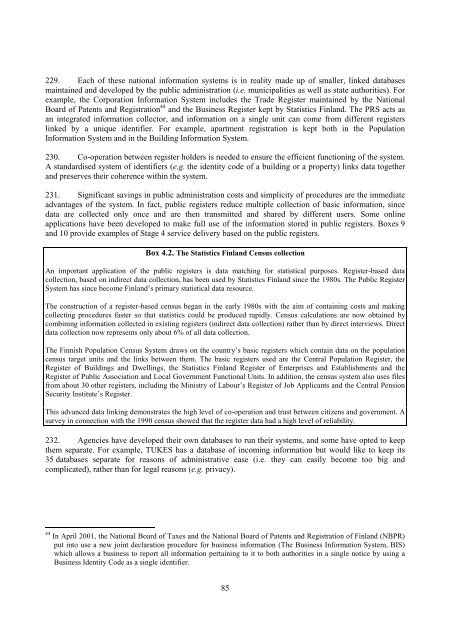e-GOVERNMENT IN FINLAND - ePractice.eu
e-GOVERNMENT IN FINLAND - ePractice.eu
e-GOVERNMENT IN FINLAND - ePractice.eu
You also want an ePaper? Increase the reach of your titles
YUMPU automatically turns print PDFs into web optimized ePapers that Google loves.
229. Each of these national information systems is in reality made up of smaller, linked databases<br />
maintained and developed by the public administration (i.e. municipalities as well as state authorities). For<br />
example, the Corporation Information System includes the Trade Register maintained by the National<br />
Board of Patents and Registration 44 and the Business Register kept by Statistics Finland. The PRS acts as<br />
an integrated information collector, and information on a single unit can come from different registers<br />
linked by a unique identifier. For example, apartment registration is kept both in the Population<br />
Information System and in the Building Information System.<br />
230. Co-operation between register holders is needed to ensure the efficient functioning of the system.<br />
A standardised system of identifiers (e.g. the identity code of a building or a property) links data together<br />
and preserves their coherence within the system.<br />
231. Significant savings in public administration costs and simplicity of procedures are the immediate<br />
advantages of the system. In fact, public registers reduce multiple collection of basic information, since<br />
data are collected only once and are then transmitted and shared by different users. Some online<br />
applications have been developed to make full use of the information stored in public registers. Boxes 9<br />
and 10 provide examples of Stage 4 service delivery based on the public registers.<br />
Box 4.2. The Statistics Finland Census collection<br />
An important application of the public registers is data matching for statistical purposes. Register-based data<br />
collection, based on indirect data collection, has been used by Statistics Finland since the 1980s. The Public Register<br />
System has since become Finland’s primary statistical data resource.<br />
The construction of a register-based census began in the early 1980s with the aim of containing costs and making<br />
collecting procedures faster so that statistics could be produced rapidly. Census calculations are now obtained by<br />
combining information collected in existing registers (indirect data collection) rather than by direct interviews. Direct<br />
data collection now represents only about 6% of all data collection.<br />
The Finnish Population Census System draws on the country’s basic registers which contain data on the population<br />
census target units and the links between them. The basic registers used are the Central Population Register, the<br />
Register of Buildings and Dwellings, the Statistics Finland Register of Enterprises and Establishments and the<br />
Register of Public Association and Local Government Functional Units. In addition, the census system also uses files<br />
from about 30 other registers, including the Ministry of Labour’s Register of Job Applicants and the Central Pension<br />
Security Institute’s Register.<br />
This advanced data linking demonstrates the high level of co-operation and trust between citizens and government. A<br />
survey in connection with the 1990 census showed that the register data had a high level of reliability.<br />
232. Agencies have developed their own databases to run their systems, and some have opted to keep<br />
them separate. For example, TUKES has a database of incoming information but would like to keep its<br />
35 databases separate for reasons of administrative ease (i.e. they can easily become too big and<br />
complicated), rather than for legal reasons (e.g. privacy).<br />
44 In April 2001, the National Board of Taxes and the National Board of Patents and Registration of Finland (NBPR)<br />
put into use a new joint declaration procedure for business information (The Business Information System, BIS)<br />
which allows a business to report all information pertaining to it to both authorities in a single notice by using a<br />
Business Identity Code as a single identifier.<br />
85
















